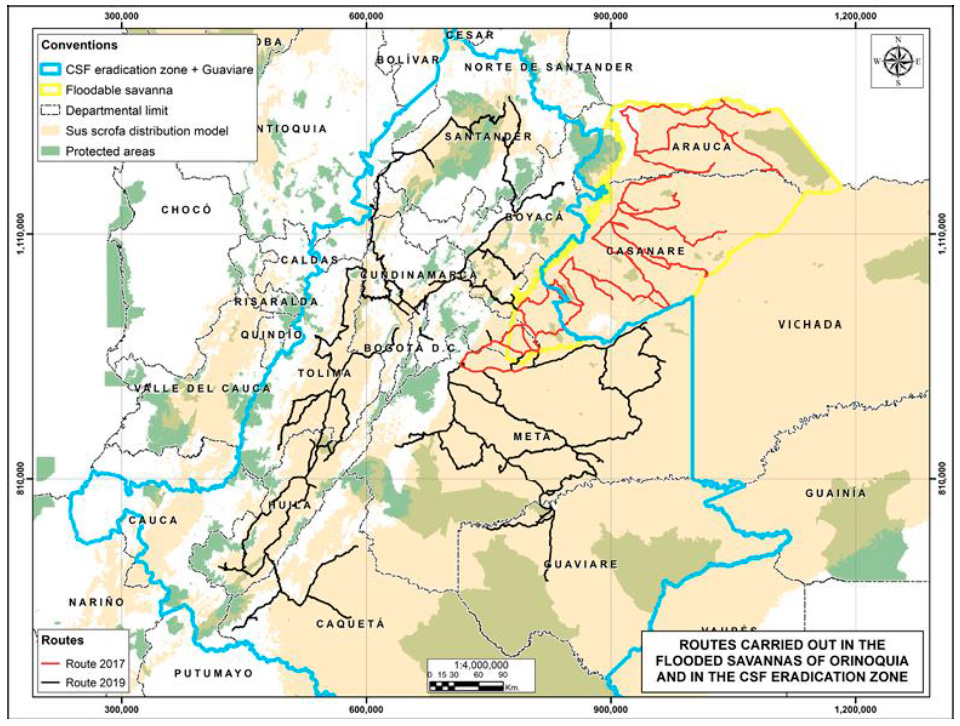Introduction
The pig (Sus scrofa Linnaeus, 1758) is an artiodactyl mammal (with even hoofs) belonging to the Suidae family, which comprises five genera and a total of 19 species (Wilson & Reeder, 2005). Sus scrofa is a species native to Eurasia and is currently found on all continents (Velázquez, 2016). The history of the pig is strongly linked to that of man. Many domestic animals arrived in the American territory in the different trips made by the Spanish conquerors, through which S. scrofa was spread throughout the continent (Carrero, 2005). In 1493, the pig reached the Caribbean islands during the second voyage of Christopher Columbus, and in 1536, the species was introduced to Colombian territory by Sebastián de Belalcázar from Quito (Carrero, 2005; Del Río, 1996; Ramírez-Chaves et al., 2011).
Currently, the feral pig is classified among the 100 most harmful invasive alien species in the world (Ramírez-Chaves et al., 2011) given that it has high resistance and great ecological, morphological, and behavioral adaptation capacity, making it a successful species in the wild (Gabor & Hellgren, 2000; Graves, 1984; Medellín et al., 2000; Merino & Carpinetti, 2003).
The pig is a species subjected to different management types around the world (Food and Agriculture Organization of the United Nations et al., 2010; Ly & Rico, 2006). Management is defined as the art of using the land to produce sustained fauna harvests for exploitation purposes (Comisión Nacional Forestal, 2009). In this way, two management categories have been established: extensive (free breeding) and intensive (breeding in confinement or enclosure) (Comisión Nacional Forestal, 2009). When animals are raised in pens or pigsties, the structure of their shelters varies from simple pens made with local materials to high-tech housings (Ballina, 2010). On the other hand, individuals under free breeding management are found in the natural habitat, feed autonomously, and are captured periodically to carry out vaccination, marking, sterilization, and harvesting tasks (Barlocco & Vadell, 2011; González, 2005; González et al., 2001; Machado & Hötzel, 2000).
In Colombia, pork meat consumption has doubled in recent years, and a further increase is projected in the coming years (Redacción Negocios y Economía, 2016). However, since the 1940s, there have been outbreaks of classical swine fever (CSF), which, presumably entered the country in 1942 from Venezuela. Consequently, with the implementation of Law 623 of 2000, the social interest to eradicate CSF in the country was declared; through Resolution 2129 of 2002, the commercialization and distribution of the CSF vaccine were regulated, and with Resolution 00593 (2003), the obligation to identify the vaccinated animals in the national territory with the official tag was established. According to the CSF eradication program, disease-free areas, areas ongoing eradication processes, and control areas were declared. In the latter, the CSF virus still circulates. Each of these zones has a specific color tag to maintain the control of individuals in the national territory (Instituto Colombiano Agropecuario [ICA], n. d.).
The current work is the product of a series of agreements made between Universidad Nacional de Colombia and Asociación Porkcolombia - Fondo Nacional de la Porcicultura, which focused on identifying the populations of feral pigs and those that are under different types of artisanal management in various departments of the country (López-Arévalo et al., 2018). Through the application of semi-structured interviews, data were collected to describe the different types of non-technified management in the epidemiological zone under CSF eradication, and in the flooded savannas of the Colombian Orinoquia. Likewise, some economic and social aspects related to pig farming were analyzed.
Materials and methods
Study area
Samplings were carried out considering the regionalization of the CSF control areas, including the border area comprising the flooded savannas of the departments of Arauca, Casanare, and Meta in the disease eradication area, and the department of Guaviare, classified as a CSF free zone.
Due to the size of the study area, visit sites were prioritized according to the probability of finding individuals according to the distribution model of the species (López-Arévalo et al., 2018). For the analysis of the results, the study area was divided considering the natural regions of Colombia: the Amazon region (Caquetá and Guaviare), the Orinoquia region (Arauca, Casanare, and Meta), and the Andean region (Cauca, Santander, Boyacá, Cundinamarca, Huila, and Tolima). The departments of Antioquia and Caldas are located in the CSF-free zone, and therefore, these were not included in the prioritization. However, some sectors were visited, and information was collected from both departments, since the route to Santander included the passage through the municipalities of Magdalena Medio that are part of Antioquia, and Caldas (figure 1).
Routes
Two routes were covered to obtain data on local pig management in the study area. The first route phase was carried out between August 17 and 26, 2017, in the frontier area. The second route phase took place between June 4 and October 24, 2019, and involved trips through the CSF eradication area, including the department of Guaviare. The routes were carried out along main, secondary, and cartable roads to cover the municipalities and veredas (small suburban countryside districts) furthest from the urban centers, taking into account the information provided by Porkcolombia on pig farms.
Daily routes were planned using the cartography from Instituto Geográfico Agustín Codazzi at a scale of 1: 100,000 and the ArcMap 10.5 software, to locate the municipalities and roads of each department to cover as much territory as possible. The end was to comply as much as possible, the routes planned daily considering the weather conditions and the state of the roads. The sampling effort was calculated based on the number of kilometers traveled per day, and considering the starting and ending points of the daily route.
During the routes, semi-structured interviews were conducted with owners, property managers, and public employees with knowledge on small and medium-scale pig production in the different municipalities visited. The interviews focused on three main topics: pig management, natural history, and diseases.
Classification of management types
The classification of the management types was made based on the pigs' dependence on the producer and the infrastructure used. In this way, four types of management were defined:
Confined: the animals are confined in shelters, from simple pens made with local materials to modern housings, and are entirely dependent on humans for food.
Outdoor enclosure: also known as large-scale open-air production or intensive open-field production (Food and Agriculture Organization of the United Nations et al., 2010; Ly & Rico, 2006). Pigs are in an intermediate state between free breeding and confined, and they move freely in large areas generally fenced with barb wire (Ly & Rico, 2006; Leite et al., 2001).
Free breeding: in this system, the pigs roam freely in the household, surrounding area, neighboring lands, or remote forests. The investment made by the producers is minimal, and the infrastructure costs for housing and food for individuals decrease.
Unmanaged: refers to feral pigs, i.e., a domestic population that has returned to its freedom condition and no longer depends on human beings for its subsistence or reproduction (Aravena, 2015).
Data analysis
With the responses collected through the semi-structured interviews, a Microsoft Excel® database was built. The interviews included questions about the origin and marketing destination of pigs, breeds, institutional presence, and sanitary conditions. Mainly, information related to the type of management, and the release of pigs to the environment (feral) was sought. The types of responses obtained, and their variations were coded. The responses were quantified and discriminated by department to show the total responses by category (total number and percentage) according to each question of the semi-structured interview.
Results and discussion
A total of 8,486.4 km were covered, and 262 semi-structured interviews were conducted with residents, municipal officials, and workers from the Colombian Agricultural Institute. In the flooded savannas of the Orinoquia region, 22 municipalities were visited, and 2,306.5 km were covered for a sampling effort of 288.31 km/day and 61 interviews in total. In the CSF eradication zone, 129 municipalities were visited, and 6,179.9 km were covered, for a sampling effort of 114.4 km/day, and a total of 201 interviews (table 1).
Table 1 Total number of interviews with settlers and officials in the routes covered by department
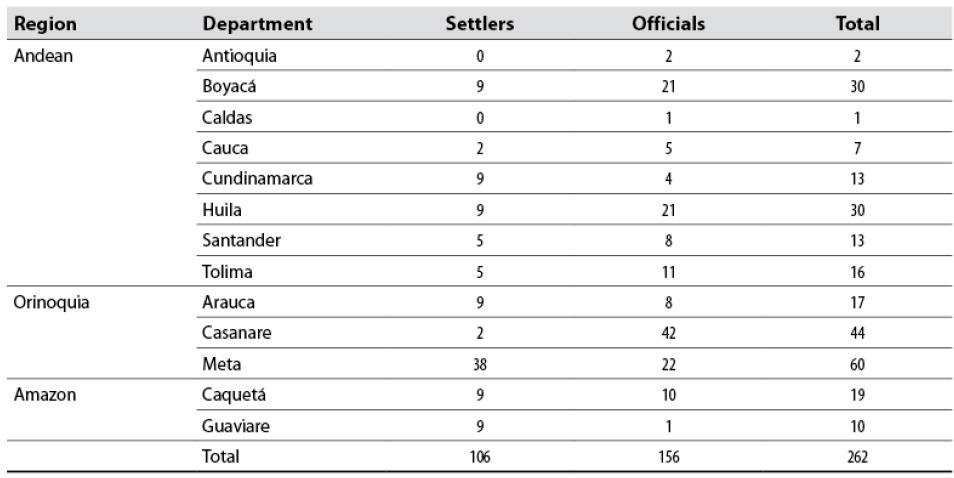
Source: Elaborated by the authors
Four management types were identified: confined, outdoor enclosure, free breeding, and unmanaged (table 2, figure 2).
Table 2 Percentage for each type of nontechnified management of pigs recorded by department
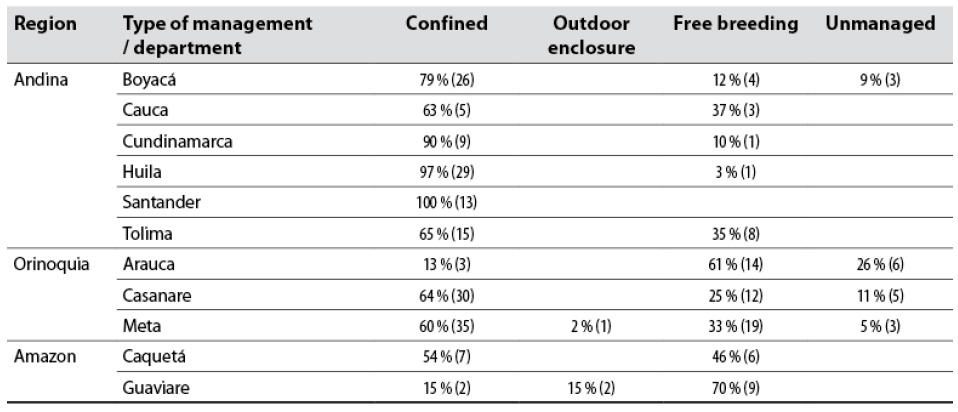
Note:the number of surveys carried out appears in parentheses. Confined management: confined and outdoor enclosure. Management without confinement: free breeding and unmanaged (feral pigs).
Source: Elaborated by the authors
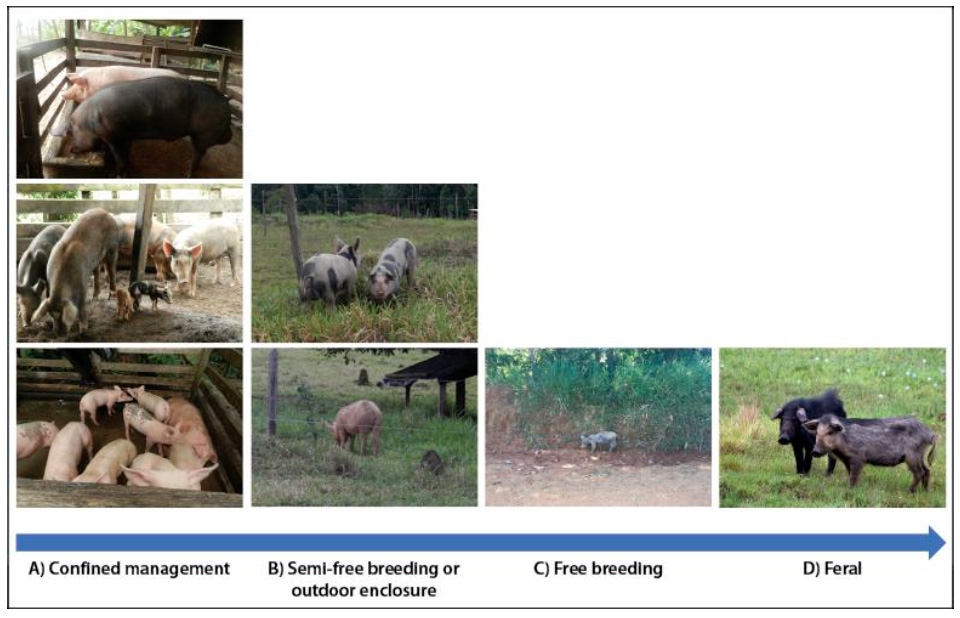
Source: Elaborated by the authors. Photographs taken by Gina Diaz and Juan Sebastián Jiménez
Figure 2 Types of pig management found in the samplings carried out
A total of 173 confined breeding records were obtained; Meta, Casanare, Huila, and Boyacá were the departments with the highest use of this type of management, generally associated with more urbanized municipalities (table 2). Small-scale confined pig production is common in households worldwide (Carrero, 2005; Castro, 2007; Food and Agriculture Organization of the United Nations et al., 2010; Sarria et al., 1999). Small producers raise pigs mainly for subsistence and, to a lesser extent, for commercial reasons (Ly & Rico, 2006). With this production system, the financial risks for small producers can be high, and there is little or no support from professional organizations (Food and Agriculture Organization of the United Nations et al., 2010).
On the other hand, management through enclosure was only recorded in Guaviare and Meta with a low frequency (table 2). This form of management has mainly economic advantages, since the producer's investment is reduced to delimiting a territory with fences, without the need to build brick and cement facilities. Moreover, being in a semi-freedom state, the pigs get by themselves much of the food they need, and, in this way, the producers only have to supplement their diet. Besides, capturing pigs in confined areas is more manageable than when they are in total freedom (Food and Agriculture Organization of the United Nations et al., 2010; Ly & Rico, 2006).
Regarding free breeding, a total of 77 records (28.5 %) were obtained, the majority from the Orinoquia region. Breeding pigs in the open air is a type of management widely used worldwide (Food and Agriculture Organization of the United Nations et al., 2010), and the first records of this practice date from the late 1950s in Europe (González, 2005). In the UK, it was known as “Roadnight” system, in France as plein air and in Spain, as camping (Barlocco & Vadell, 2011; Vadell, 1999). This type of management is widely used in Latin America and generates efficient results in the cost-benefit relationship (Barlocco & Vadell, 2011; González, 2005; González et al., 2001; Machado & Hötzel, 2000).
Free breeding is the most basic pig management system worldwide (Food and Agriculture Organization of the United Nations et al., 2010), and the one with the highest records in the departments of Arauca, Casanare, and Meta. This type of management minimizes the investment made by producers, reduces the accommodation construction costs and food, improves the solar incidence in the animals, and reduces cannibalism and waste treatment problems (Food and Agriculture Organization of the United Nations et al., 2010; González, 2005).
There are two types of free breeding. In the first, the pigs are completely loose on the property, and have contact with people only at times when vaccination or sterilization of males have to be carried out. In the second type, pigs are close to where people live or come to their homes at certain times, either to feed or in search of shelter during rainy seasons or to be kept overnight in small shelters as protection against theft or predators (Ly & Rico, 2006).
Finally, 17 records of unmanaged pig handling were obtained, most of them reported in the Orinoquia region, especially from the floodplain savannas of Arauca and Casanare (table 2). These feral pigs are animals that escaped from farms where free breeding is practiced; in certain places, the land areas are so large that some individuals never again come in contact with people. In Arauca and Casanare, it is customary to release individuals in the forest covers to gain weight and then hunt them for their meat (Ramírez-Chaves et al., 2011; Rodríguez, 2018).
Although the reports of feral pigs were few in the Andean region, the inhabitants of several municipalities confirmed that, in the past, these animals inhabited more conserved areas, but later, with urban growth, they moved away towards forest remnants. Because the main type of management in this region is the outdoor enclosure (in the backyard), the probability of pigs escaping and becoming feral is almost null.
Table 3 Characteristics associated with the recorded management types
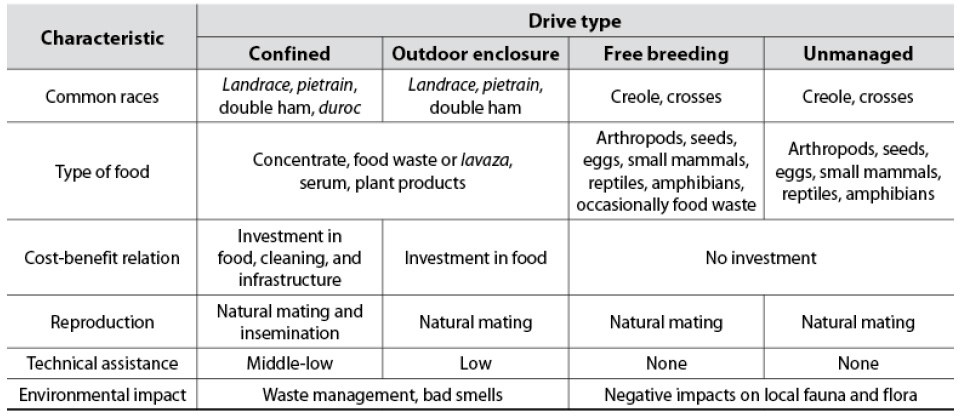
Source: Elaborated by the authors
Races
In the routes covered, a large number of phenotypes between purebreds and crosses were identified. The most common breeds in most of the departments were landrace, pietrain, double ham, and duroc, with a preference for confined and outdoor enclosure management types (table 3); as these breeds possess unique characteristics for meat production and marketing, they need greater care to obtain better yields (Carrero, 2005).
Conversely, most of the free breeding and feral individuals corresponded to creole breeds and creole crosses with any of the breeds mentioned above, as these are animals with higher resistance to changing climatic conditions and possible diseases (table 3). It is likely that these creole breeds are the result of an efficient selection by the inhabitants for more than 500 years and have arisen from phenotypes successfully adapted to these climatic conditions (Cardozo & Rodríguez, 2010; Rodríguez, 2018).
Colombian creole breeds such as casco de mula and zungo represent a biodiversity heritage because they belong to a heterogeneous population, making them reservoirs of genetic variability that enriches and refreshes commercial germplasm (Barrera et al., 2007). However, despite the advantages of creole pigs, people believe that these animals have significantly decreased because they are not as attractive to the market compared to commercial breeds.
Feeding
Feeding varies according to the type of management to which the animals are subjected (table 3). Individuals who are confined receive a diet based on concentrate and lavaza combined with farm products such as rice and corn bran, sugar cane, grounded wheat, avocado, cassava, flour, bore, soybean, banana, and palm. In Boyacá, Meta, Guaviare, and Caquetá, serum, a by-product of livestock production, is a fundamental ingredient in pig feed. However, some of the producers interviewed stated that when pigs are fed only kitchen waste, they show slow growth due to a deficit of necessary nutrients.
Free-living animals that return to the farms are mainly given lavaza to supplement the nutrition they obtain by rooting independently. However, in non-returning free breeding and in feral individuals, nutrition depends entirely on what they can find in the vast land extensions they inhabit (Food and Agriculture Organization of the United Nations et al., 2010; Ly & Rico, 2006).
Sanitary conditions
The type of management used in pig production is directly related to the appearance of diseases and the vaccination that is administered to them. Feral pigs represent a critical problem due to the great variety of diseases they can suffer (Aravena, 2015; Barrios-Garcia & Ballari, 2012; Pérez-Rivera et al., 2017; Serraino et al., 1999; Velázquez, 2016).
Despite this, in the interviews carried out, only one symptomatology report compatible with CSF was found in the municipality of Cartagena del Chairá, Caquetá. However, the interviewees stated that their pigs have suffered from other diseases, mainly during their first days of life and during pregnancy. Nonetheless, a high lack of knowledge about these diseases and their appropriate treatments was observed, showing a lack of technical support by the competent institutions, a fact that seems to be common in many parts of the world (Food and Agriculture Organization of the United Nations et al., 2010).
A higher density of pigs in small-scale confinement production systems results in an increased risk of pathogen circulation between animals. Besides, when the protection measures for the management of individuals are not indicated, the access of visitors to the confinement area is not controlled, and the presence of rodents or other animals is not reduced; this facilitates the generation and spread of diseases (Food and Agriculture Organization of the United Nations et al., 2010).
The production systems where different species are raised are an excellent strategy to mitigate financial risks, optimize the use of by-products and take advantage of space; this is the reason why they are the most used by small producers (Food and Agriculture Organization of the United Nations et al., 2010). Nevertheless, these systems can cause biosecurity problems and become risk factors for pig production because they cause diseases such as foot-and-mouth disease, rabies, and salmonellosis. Likewise, mixing animals of several species on the same farm also increases the risk of new viruses appearing (Ballina, 2010; Food and Agriculture Organization of the United Nations et al., 2010).
Free breeding pigs are also at risk of suffering diseases, as they may come into contact with feral pigs and other wildlife species such as rodents and birds (Food and Agriculture Organization of the United Nations et al., 2010). However, González (2005) and Rodríguez (2018) reported that free breeding benefits disease control, since animals can acquire different nutrients available in the environment.
One measure for disease prevention is vaccination, a vital practice in animal health that requires an action plan for each region. In the Andean, Orinoquia (Meta), and Amazon regions, there is no vaccination against CSF, since, through Resolution 11138 of 2016, these areas are in the process of being declared free of CSF (ICA, n.d.). However, in the flooded savannas (departments of Arauca and Casanare), this activity is mandatory for pork commercialization. Unfortunately, these actions are not implemented in some study area locations due to the absence of entities and the lack of monitoring and control.
In addition to the above, there are sectors where vaccination is not well accepted or is considered unnecessary. In some areas of the flooded savannas of the Colombian Orinoquia, pig owners consider that vaccination can even make the animals sick, and they only vaccinate them when they are marketed. It should be noted that vaccination to prevent diseases, such as anthrax, is essential for animal welfare (Ballina, 2010).
On the other hand, the number of reports of illegal slaughter in all the municipalities visited is worrying, and has even increased in recent years, partly as a consequence of the closure of processing plants in compliance with Decree 1500 of 2007 and its amendments. For example, until March 2019, in the Andean region, 25 pig processing plants were closed, and in the Amazon region (Guaviare), one was closed (Instituto Nacional de Vigilancia de Medicamentos y Alimentos, 2019).
Although one of the objectives of the regulations is to guarantee sanitary conditions in the processing plants and, in general, in each section of the production chain, the prohibition, and closure of slaughterhouses has left the local population with few options and, in many cases, authorized plants are few and far away. The use of these plants represents additional costs, time, and mobilization, which has indirectly led to the illegal slaughter of pigs on the farms.
In these illegal spaces, sanitary conditions are even lower or even non-existent. No trained personnel or control entities are accompanying the procedure or evaluating the quality and condition of the animals, so there may be foci of highly spreading diseases. In addition, since local consumption also occurs informally, primarily with sales between neighbors, there may be no early disease warning.
Overall, there is a low presence of institutions that guide pig management in small, non-technified productions, and the residents express the need for training, support, and incentives so that pig farming becomes a profitable practice. In the large pig production plants or farms, the interviewees reported greater support from both Porkcolombia and the Colombian Agricultural Institute; this is why it is necessary to focus more efforts on small and medium producers.
Due to the little financial support offered to small breeders in the study area, a growing demotivation for pig farming is observed, since this activity is not profitable or the profits are minimal (table 3), among other reasons, due to the high prices of concentrate to feed pigs. Added to this, are the costs of moving the animals to the processing plants that are still in operation. In many places, this work continues, not because of its economic representation in the income of each farm, but because of the tradition of raising pigs and self-consumption (Food and Agriculture Organization of the United Nations et al., 2010). It is essential to pay attention to small and medium-scale producers and recognize their work as suppliers of large quantities of meat in small municipalities.
Environmental impact of the types of management
Breeding pigs under confinement conditions presents a series of relevant negative impacts on ecosystems, due to the enormous volumes of waste and the high risks to animal and human health (Cáceres & Forero, 2015). This type of management generates water sources contamination by nitrogen and phosphorus contained in the excreta; furthermore, an exaggerated volume of this resource is required to clean and maintain confinements. Likewise, air quality is altered by the numerous burns to eliminate vaccination syringes, bags, and containers, and by the bad odors that these residues emanate (Cáceres & Forero, 2015).
Pigs that are found in extensive systems (free breeding) or without management (feral) can generate an imbalance in the soils by consuming edaphic arthropods involved in fundamental processes such as the decomposition of different elements (Vtorov, 1993). Moreover, they can significantly affect the structure and composition of plant communities by altering their rooting and reducing plant cover, diversity, and regeneration (Arnaud et al., 2014; Barrios-Garcia & Ballari, 2012; Goulding & Roper, 2002; Kotanen, 1995).
In the same way, these pigs directly affect the local fauna, since they feed on eggs, young birds, and reptiles that nest on the ground, and actively consume mammals, reptiles, small amphibians, and insects (Senserini & Santilli, 2016; Serraino et al., 1999; Van Riper & Scott, 2001). Moreover, they compete with other wild animals for vital resources, often displacing local fauna (Serraino et al., 1999) and can even be vectors of diseases for livestock or wildlife (Barrios-Garcia & Ballari, 2012; Serraino et al., 1999).
Conclusions
In the routes covered, four types of pig management were identified related to the extension of available land, the proximity to populated centers, and the socio-cultural and economic traditions of each region. These management types differ in the need for care for the animals, the economic investment, and the risk of escape or release that generates feral individuals. A case of symptoms compatible with CSF was reported in Caquetá, and the authorities in charge must verify the veracity of this report.
Different records of other diseases (undiagnosed) or symptoms that led to the death of newborn pigs and pregnant females were obtained. In most cases, the producers are not aware of the diseases or the appropriate treatments, among other reasons, due to the lack of support from the institutions in charge.
The slaughter tasks are carried out, mostly, illegally, due to the closure of processing plants that did not comply with current regulations. Given the lack of control and accompaniment, illegal slaughter can be a focus of diseases without early warnings.











 text in
text in 


